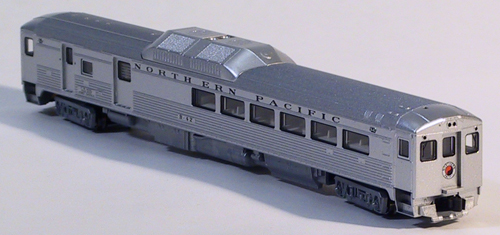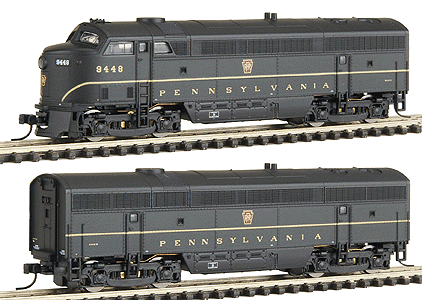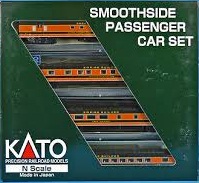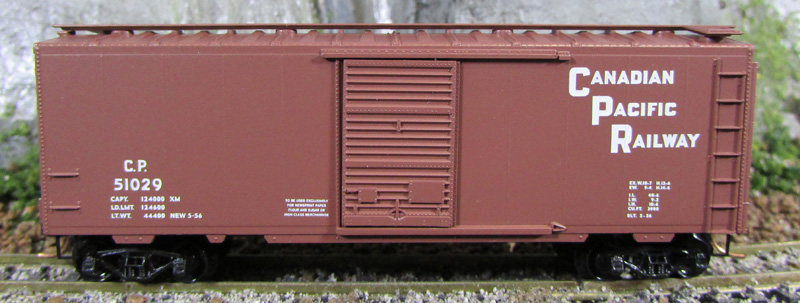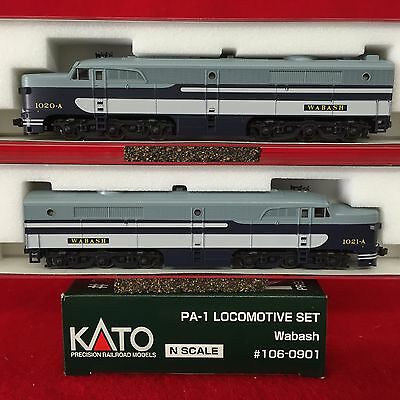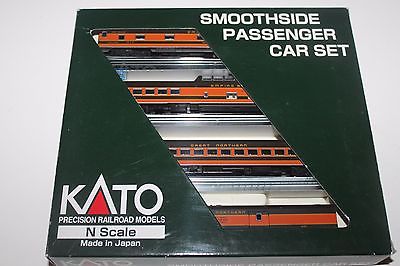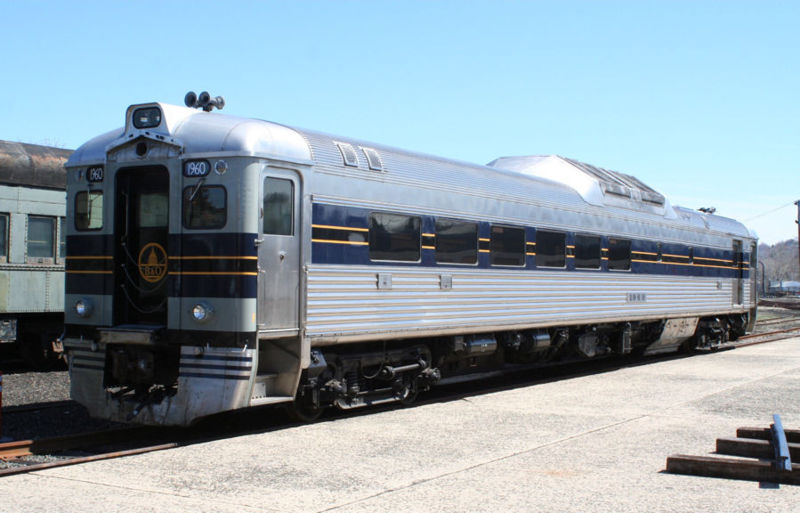Specific Item Information: With the massive number of branch lines in its service, the Northern Pacific found the RDC useful for running branch and connecting line services across its main line. Originally part of Western Pacific's fleet, the NP picked up its first RDCs in 1962, using them as stand ins for regular service on the Fargo to Winnipeg service. They later added a DM&IR RDC-3 to their service in 1963.
Model Information: All models are motorized, have LED directional headlights, and KATO magnetic knuckle coupers. Interiors can be lighted with the optional #11-209 & #11-210 Interior Light Kit with White LED or #11-204 & #11-206 Interior Light Kit with bulb.
Click here for Kato RDC magazine ad
Click here for Kato RDC magazine ad
DCC Information: The RDC is DCC friendly for an installation of a Digitrax Digitrax DN143K2 Decoder. Not really drop-in, installation requires a lot of care.
Prototype History: This Single-car DMU is commonly known as the "RDC," the motorized Rail Diesel Car generally operated in rural areas where ridership and mail/parcel transport were too low for regular passenger train service. When first introduced, the RDC was also proclaimed to be the savior of branch line and suburban service. It was heavily used as a commuter service workhorse (and still is currently in some locations!).
The Budd Company rolled out the first RDC in the fall of 1949, a single RDC-1 "Budd Demonstrator." Hundreds more would eventually follow for service to railroads throughout North America and around the world (including South America, Australia, Saudi Arabia and even Cuba!). Oddly enough, it was Budd's experience in the production of small yet powerful diesel engines for WWII tanks that eventually lead to the birth of the RDC.
A total of 398 units were built. The RDC utilized two compact motors mounted under the car's floor to drive one axle on each truck. Capable of being operated by a motorman from either end of the car, these units could be used independently or combined to create a two- or three-unit consist. These railcars cold achieve as top speed of 85mph
A review of the Budd roster reveals that many RDC cars were operated well into the 1970's and early 1980's, with a small number still in service today!
Four standardized designs were created to reduce the time and expense of custom production
- RDC-1 was strictly passenger-oriented, containing 90 coach seats.
- RDC-2 contained 71 seats and a separate baggage area.
- RDC-3 combined a Railway Post Office with a baggage compartment and 49 seats.
- RDC-4 was a self-contained RPO-Express car.
Read more on Wikipedia.
The Budd Company rolled out the first RDC in the fall of 1949, a single RDC-1 "Budd Demonstrator." Hundreds more would eventually follow for service to railroads throughout North America and around the world (including South America, Australia, Saudi Arabia and even Cuba!). Oddly enough, it was Budd's experience in the production of small yet powerful diesel engines for WWII tanks that eventually lead to the birth of the RDC.
A total of 398 units were built. The RDC utilized two compact motors mounted under the car's floor to drive one axle on each truck. Capable of being operated by a motorman from either end of the car, these units could be used independently or combined to create a two- or three-unit consist. These railcars cold achieve as top speed of 85mph
A review of the Budd roster reveals that many RDC cars were operated well into the 1970's and early 1980's, with a small number still in service today!
Four standardized designs were created to reduce the time and expense of custom production
- RDC-1 was strictly passenger-oriented, containing 90 coach seats.
- RDC-2 contained 71 seats and a separate baggage area.
- RDC-3 combined a Railway Post Office with a baggage compartment and 49 seats.
- RDC-4 was a self-contained RPO-Express car.
Read more on Wikipedia.
Road Name History:  The Northern Pacific Railway (reporting mark NP) was a transcontinental railroad that operated across the northern tier of the western United States from Minnesota to the Pacific Coast. It was approved by Congress in 1864 and given nearly 40 million acres (160,000 km2) of land grants, which it used to raise money in Europe for construction. Construction began in 1870 and the main line opened all the way from the Great Lakes to the Pacific when former president Ulysses S. Grant drove in the final "golden spike" in western Montana on Sept. 8, 1883.
The Northern Pacific Railway (reporting mark NP) was a transcontinental railroad that operated across the northern tier of the western United States from Minnesota to the Pacific Coast. It was approved by Congress in 1864 and given nearly 40 million acres (160,000 km2) of land grants, which it used to raise money in Europe for construction. Construction began in 1870 and the main line opened all the way from the Great Lakes to the Pacific when former president Ulysses S. Grant drove in the final "golden spike" in western Montana on Sept. 8, 1883.
The railroad had about 6800 miles of track and served a large area, including extensive trackage in the states of Idaho, Minnesota, Montana, North Dakota, Oregon, Washington and Wisconsin. In addition the company had an international branch to Winnipeg, Manitoba, Canada. The main activities were shipping wheat and other farm products, cattle, timber and minerals; bringing in consumer goods, transporting passengers; and selling land.
The company was headquartered first in Brainerd, Minnesota, then in Saint Paul, Minnesota. It had a tumultuous financial history, and in 1970 it merged with other lines to form the Burlington Northern Railroad.
Read more on Wikipedia.

The railroad had about 6800 miles of track and served a large area, including extensive trackage in the states of Idaho, Minnesota, Montana, North Dakota, Oregon, Washington and Wisconsin. In addition the company had an international branch to Winnipeg, Manitoba, Canada. The main activities were shipping wheat and other farm products, cattle, timber and minerals; bringing in consumer goods, transporting passengers; and selling land.
The company was headquartered first in Brainerd, Minnesota, then in Saint Paul, Minnesota. It had a tumultuous financial history, and in 1970 it merged with other lines to form the Burlington Northern Railroad.
Read more on Wikipedia.
Brand/Importer Information: KATO U.S.A. was established in 1986, with the first U.S. locomotive model (the GP38-2, in N-Scale) released in 1987. Since that time, KATO has come to be known as one of the leading manufacturers of precision railroad products for the modeling community. KATO's parent company, Sekisui Kinzoku Co., Ltd., is headquartered in Tokyo, Japan.
In addition to producing ready-to-run HO and N scale models that are universally hailed for their high level of detail, craftsmanship and operation, KATO also manufactures UNITRACK. UNITRACK is the finest rail & roadbed modular track system available to modelers today. With the track and roadbed integrated into a single piece, UNITRACK features a nickel-silver rail and a realistic-looking roadbed. Patented UNIJOINERS allow sections to be snapped together quickly and securely, time after time if necessary.
The Kato U.S.A. office and warehouse facility is located in Schaumburg, Illinois, approximately 30 miles northwest of Chicago. All research & development of new North American products is performed here, in addition to the sales and distribution of merchandise to a vast network of wholesale representatives and retail dealers. Models requiring service sent in by hobbyists are usually attended to at this location as well. The manufacturing of all KATO products is performed in Japan.
Supporters of KATO should note that there is currently no showroom or operating exhibit of models at the Schaumburg facility. Furthermore, model parts are the only merchandise sold directly to consumers. (Please view the Parts Catalog of this website for more specific information.)
In addition to producing ready-to-run HO and N scale models that are universally hailed for their high level of detail, craftsmanship and operation, KATO also manufactures UNITRACK. UNITRACK is the finest rail & roadbed modular track system available to modelers today. With the track and roadbed integrated into a single piece, UNITRACK features a nickel-silver rail and a realistic-looking roadbed. Patented UNIJOINERS allow sections to be snapped together quickly and securely, time after time if necessary.
The Kato U.S.A. office and warehouse facility is located in Schaumburg, Illinois, approximately 30 miles northwest of Chicago. All research & development of new North American products is performed here, in addition to the sales and distribution of merchandise to a vast network of wholesale representatives and retail dealers. Models requiring service sent in by hobbyists are usually attended to at this location as well. The manufacturing of all KATO products is performed in Japan.
Supporters of KATO should note that there is currently no showroom or operating exhibit of models at the Schaumburg facility. Furthermore, model parts are the only merchandise sold directly to consumers. (Please view the Parts Catalog of this website for more specific information.)
Item created by: Alain LM on 2017-08-13 13:45:41. Last edited by CNW400 on 2020-06-22 23:26:54
If you see errors or missing data in this entry, please feel free to log in and edit it. Anyone with a Gmail account can log in instantly.
If you see errors or missing data in this entry, please feel free to log in and edit it. Anyone with a Gmail account can log in instantly.


